The Intergalactic Nemesis
A Transmedia Multiverse Trilogy
The Intergalactic Nemesis trilogy melds the audio drama of radio serials and the visual spectacle of the graphic novel within a live performance (billed as a “Live Action Graphic Novel”). Developed over two decades in an array of coffee houses, theatre spaces, and radio stations in Austin, Texas, The Intergalactic Nemesis has evolved from an uncertain theatrical experiment to an epic, live-action, multimedia event—or, in the words of creator Jason Neulander, “independently-produced transmedia multiverse”—that has toured venues across the nation and the globe. (See what W.M. Akers wrote on HowlRound about the trilogy’s first installment here.)
But The Intergalactic Nemesis is not simply a stage version of a comic book story. When its audience arrives to whatever ornate theatre, university auditorium, or movie house happens to be hosting that evening’s (or afternoon’s) show, the promised spectacle of a “Live-Action Graphic Novel” is typically nowhere to be seen. Instead, on the stage, an array of equipment sits idly in front of a wide projection screen. At one side of the playing space is an electric piano. On the other rests what appears to be a control booth, unconcealed, with mixing boards and computer monitors anchoring an eruption of wires and cables. Between the piano and the booth, three “old timey” radio-style microphones stand at attention and, not too far away, a fourth microphone looms ominously above a table laden with an enormous collection of incongruous objects.
Amidst its elaborate media apparatus, The Intergalactic Nemesis remains an emphatically live performance. Nothing in the show is pre-recorded, pre-cued, or pre-mixed.
These components—screen, board, piano, microphones, and random objects—remain inanimate until the cast of The Intergalactic Nemesis arrives on stage to begin the performance. Three actors (Rachel Landon, Brock England, and Christopher Lee Gibson) take their place at the standing microphones, through which they will each soon give voice to dozens of characters (originally conceived by Ray Patrick Colgan, Lisa D’Amour, Julia Edwards, Jessica Reisman, and Jason Neulander). A foley artist (Kelly Matthews) steps behind the table of objects, from which she will enact hundreds of sound effects (created by Buzz Moran). A musician (Harlan Hodges) sits at the electric piano, upon which he will riff and improvise upon score lines (composed by Graham Reynolds). The sound engineer (George R. Stumberg IV) and company manager (Jessie Douglas) also take their place at their respective consoles, remaining in full view on stage as they mix the many sounds soon to be heard and manually cue the hundreds of “comic book” images (by Tim Doyle and David Hutchison) soon to be projected as storyboard panels on the big screen.
Amidst its elaborate media apparatus, The Intergalactic Nemesis remains an emphatically live performance. Nothing in the show is pre-recorded, pre-cued, or pre-mixed. In each performance, The Intergalactic Nemesis ensemble makes a show out of the intricate mixing, voicing, and sounding work typically enacted invisibly within familiar media entertainments. Thus, amplified by the spontaneities of liveness, the hybrid intermediality of The Intergalactic Nemesis trilogy unveils the apparatus of cinematic illusion (actors at microphones, musicians at keyboards, foley artists at play, digital mixers at work) and reveals the thrilling theatricality of that apparatus as spectacle. At the same time, The Intergalactic Nemesis also prompts its all-ages audience use their imaginative powers to choose their own spectacular adventure, to use the tools provided by their theatrical imagination, and to complete the illusion—in short, to make a movie in the moment with their minds.
The Intergalactic Nemesis trilogy is co-written by Chad Nichols and Jason Neulander and each of its three full-length narrative parts follows Molly Sloan, an intrepid prize-winning journalist, as she investigates a diabolical interplanetary scheme to destroy humanity. In Target Earth, the trilogy’s first installment, Molly Sloan and her research assistant Timmy Mendez, along with Ben Willcott (a mysterious librarian from Flagstaff, Arizona, who seems to know a lot about the future), must travel the globe and the galaxy to first investigate and then battle an invading horde of vicious, parasitic, mind-controlling sludge-monsters. Shortly after Molly Sloan and her team save humanity from the Zygonian sludge-monsters’ scheme to colonize earth, the trilogy’s second segment begins as an inexplicable glitch in its operating system threatens the utopic robot planet of Robonovia. In Robot Planet Rising, Molly Sloan must decide who—her former fiancé Dr. Lawrence Webster; the mysterious Dr. Natasha Zorokov; the Robonovian defense minister Alphatron; and a different Ben Willcott (this one a geneticist from Flagstaff, who somehow also seems to know a lot about the future)—can be trusted to join her and Timmy Mendez to save earth, Robonovia, and indeed the galaxy from the persisting Zygonian threat. In the trilogy’s final chapter, Twin Infinity, Molly Sloan must travel the globe, the galaxy and time itself to stop a mad scientist’s scheme to breed a hybrid human-alien master race, even as she seeks to understand which Ben Willcott (the librarian or the geneticist) is the man she truly loves.
The Intergalactic Nemesis began its theatrical adventure nearly twenty years ago in Austin, Texas. In 1996, writer-musician Ray Colgan approached Jason Neulander (founder and original Artistic Director of Austin’s influential Salvage Vanguard Theater) with the idea of performing a science fiction radio serial live on stage. In its initial iteration, the piece took shape over five weeks. Each week, Colgan and a team of writers composed two fifteen-minute scripts that Neulander would stage with a team of actors and technicians for a single set of Sunday evening performances at a local coffeehouse. The experiment proved a surprise hit among audiences, who returned week to week. Foley artist Buzz Moran (who improvised the sound effects) recorded the live shows on four-track cassette and, the following year, Austin’s public radio station aired the full series in serial format. Several years later, Moran approached Neulander about restaging the series as a single evening’s entertainment and capturing a broadcast quality recording. Neulander reassembled many from the 1996 team and, in the early summer of 2000, the single evening version of Intergalactic Nemesis premiered at Austin’s State Theatre to enthusiastic response, prompting plans for the staging and recording of what would become 2001’s successful sequel, Return of the Intergalactic Nemesis. In the summer of 2002, the two shows were performed live in repertory and again aired on Austin’s KUT radio. A third installment of the onstage radio serial was first staged at Salvage Vanguard in 2005.
The franchise discovered new life in 2009 when, while collaborating with artist Tim Doyle (who had created stage backdrops) about creating a graphic novel version of the stories in classic comic-book style, Neulander hit upon the idea of integrating the new art within a retooled version of the live show. In 2010, Target Earth—the first installment of the new Intergalactic Nemesis trilogy—premiered, with plans for two sequels underway as Neulander and his Intergalactic Nemesis team undertook a multi-year international tour to more than 150 venues, which has included stops at the Kennedy Center, New York’s New Victory Theater, and TBS’s Conan show in Los Angeles. Intergalactic Nemesis graphic novels are in print, and an online version of the project has been produced in collaboration with Austin’s KLRU-TV, with funding support from PBS Digital Studios, and is available for viewing online here. At present, Neulander is developing a novel series based on one of Intergalactic Nemesis’ most popular supporting characters, Jean-Pierre Desperois, as the team readies for their first Australian tour. Most recently, the full trilogy of Intergalactic Nemesis was presented over two weekends at Austin’s Alamo Drafthouse, where I saw all three installments.
Over two decades, The Intergalactic Nemesis has built a world unto itself. The trilogy draws giddily upon genre and canon in equal measure even as it also crafts its own original mythology from within, configuring a complex narrative universe driven more by adventure than emotion and populated by characters compelled more by thrilling plotting than by archetypal heroics. But Intergalactic Nemesis is not simply a product of the scrappy aesthetics of Austin’s dynamic independent film, theatre, and music scenes. The trilogy—with its audacious simplicity, pop cultural fervor, and audience-centered development process—also stands as an unexpected exemplar of Austin’s distinctively participatory practice of theatremaking. The Intergalactic Nemesis stages not simply a play but also the act of playing itself, while inviting the audience to join in the imaginative plays of performance making.
Over two decades, The Intergalactic Nemesis has built a world unto itself. The trilogy draws giddily upon genre and canon in equal measure even as it also crafts its own original mythology from within, configuring a complex narrative universe driven more by adventure than emotion and populated by characters compelled more by thrilling plotting than by archetypal heroics.
The Intergalactic Nemesis reveals its own apparatus even as it revels in it. The production provides you the components. How you assemble them into an experience remains up to you. You might lose yourself in the virtuosity of the vocal performers, the technological wonderment of the engineer’s mixing, the crafty dexterity of the foley artistry, or the visual spectacle of the storyboard panels as they slide across the screen. You might also join the cheering and booing offered by your fellow audience members, or delight at the many moments of vamping interaction from the onstage ensemble. The cast’s able exploitation of the knowing pause, the mugging glance, and the conspicuously extended sound/music effect also provide a wink of collaborative recognition between performer and audience. Whether you follow a particular track for a few moments, for a few minutes, or for the whole show, The Intergalactic Nemesis maximizes the inceptive promise of live theatre by allowing the audience to complete the illusion staged by the event.
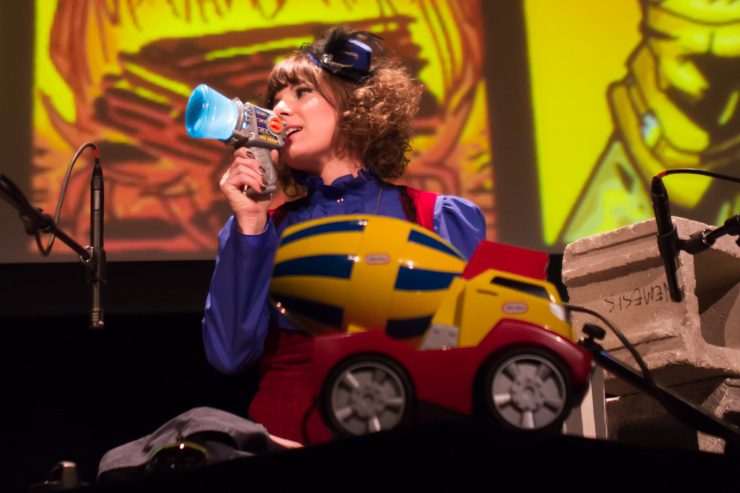
In many ways, The Intergalactic Nemesis seems perhaps ideally suited for the fan-oriented ecosystem of its contemporary moment, one in which the most popular entertainments (whether movies, video games, or theme park attractions) provide multiple points of active engagement even as they promise an immersive experience. By so simultaneously delighting in the apparatus of cinematic illusion making, The Intergalactic Nemesis reactivates the theatrical pleasures of adventure, fantasy, and science fiction storytelling, while also staging an intriguing counterpoint to the widespread mediatization of the theatrical event on commercial and not-for-profit stages. Yet, even as it embarks on its fifth successful year of touring, The Intergalactic Nemesis appears to be finding itself at a development plateau.
The Intergalactic Nemesis’s success on the road, however enviable, has delivered its team to a crossroads of sorts, raising questions about the trilogy’s sustainability. The very iconoclasm of genre and form that heralds the trilogy’s artistic ambition and independent spirit have made it an occasionally tough sell, especially for presenters wary of anything that’s not an immediately legible commodity. (Like touring musicians, The Intergalactic Nemesis team has learned that, to subsidize their actual operating expenses while on the road, the production must rely upon sales of merchandise rather than upon their diminishing cut of ticket sales.) The Intergalactic Nemesis is an innovative work of transmedial live performance that defies simple description even as it aims for broad, popular appeal.
The Intergalactic Nemesis is a fan-oriented entertainment that, quite simply, needs more fans if it is to survive in the long-term. Its noteworthy recent success therefore also underscores peculiar challenges facing independent performance-makers seeking to create innovative, experiential entertainments addressing audiences who may not consider themselves theatregoers. Can independent theatre artists kick start their own franchise from scratch? Can innovative theatremakers attract entertainment-seeking audiences without the ready-made platforms provided by Disney, Marvel, Shakespeare, Top 40, or some other canon? Is genre-defying work like The Intergalactic Nemesis just too idiosyncratic for theatrical presenters (commercial, not-for-profit, or independent) to embrace? If even an indie “transmedia” phenom like The Intergalactic Nemesis can’t totally break free of the rigid marketing and programming “categories” still used by most major presenting organizations, what might that tell us about where live theatrical work does and does not “fit” within the shifting entertainment ecosystem of our contemporary moment?
Such are the uncertainties looming on the horizon for The Intergalactic Nemesis, threats that may yet prove too diabolical for even our intrepid hero Molly Sloan.


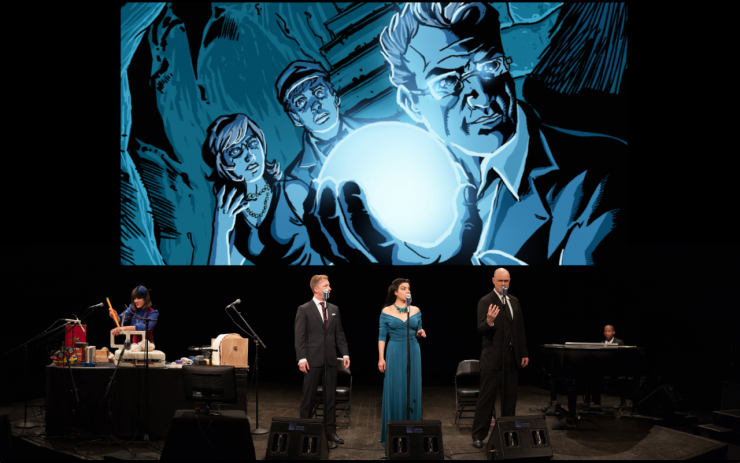
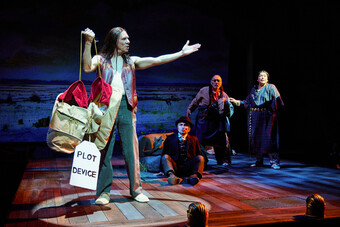

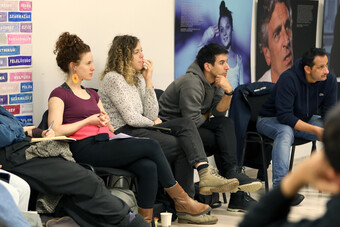


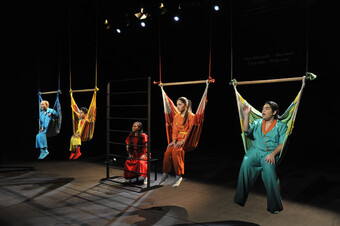


Comments
The article is just the start of the conversation—we want to know what you think about this subject, too! HowlRound is a space for knowledge-sharing, and we welcome spirited, thoughtful, and on-topic dialogue. Find our full comments policy here
Articles like this make me miss ATX. All the things I missed before I discovered theatre, just a clarinet band geek in the marching band. I hope The Intergalactic Nemesis finds its way to Canada at some point. I would bring all my friends, theatre and non-theatre, to experience it.